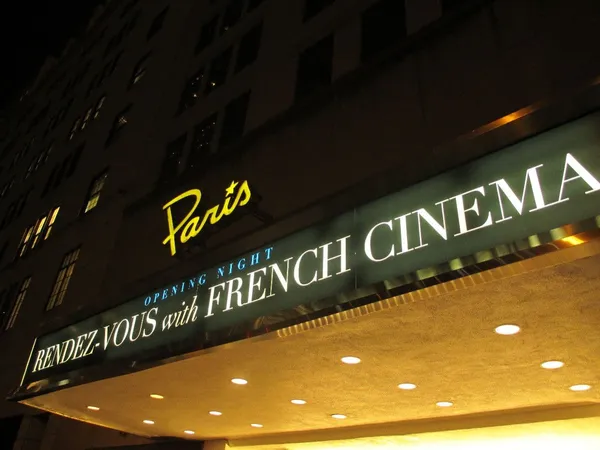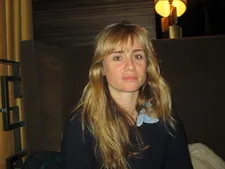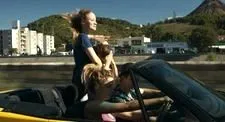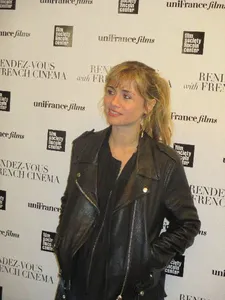 |
| Opening night at The Paris Theatre for Rendez-Vous with French Cinema in New York Photo: Anne-Katrin Titze |
Katell Quillévéré's potent Suzanne, screening in the 19th edition of Rendez-Vous with French Cinema in New York, stars Sara Forestier, Adèle Haenel, François Damiens, and Paul Hamy. The afternoon after the opening night screening of On My Way at The Paris Theatre, I spoke with Katell at the Empire Hotel, near Lincoln Center on her choice of a Nina Simone recording of a Leonard Cohen song, casting with chemistry, writing the script, and how she put it all together.
Quillévéré introduces her protagonist Suzanne as a child, getting ready for a school performance. Her truck driver father (Damiens) and older sister (the younger Maria played by Fanie Zanini) are in the audience, the mother is dead. The grave and the father's truck become the rest stops where the family gathers after their singular adventures in the world. Time jumps and tumbles on and we have to catch up with her life. "This is not me," turns out to be the line that breaks the criminal spell in this story built on sisterly love, while family members ferry away and towards each other and the sun sets over the dunes.
Anne-Katrin Titze: Was it clear to you early on for the structure of your film that you would start with Suzanne as a little girl [played by Apollonia Luisetti], all sparkly and excited, anticipating her dance performance, with the whole of life in front of her?
 |
| Katell Quillévéré at the Empire Hotel on Sara Forestier as Suzanne: "She wants to return to being that little girl who wants life to be very intense." Photo: Anne-Katrin Titze |
Katell Quillévéré: No, in fact I came to this idea in the process of writing and it took quite a bit of time to find how to open the film. It's very important to me, the first scene, because it's the moment in which the spectator is deciding how to enter the film, whether they're going to enter the film. It was a choice that was not at all theoretical, it came from somewhere very deep. And from having had that same relationship to performance as a child. Having that feeling that life is extremely special and going onto the stage and having people looking at you. In that moment things are very intense and afterwards there's a certain melancholy that comes over you. I think that's what Suzanne continues to look for throughout her life. She wants to return to being that little girl who wants life to be very intense.
AKT: The scene already introduces the family dynamics.
KQ: It puts into place the family relations we see throughout the film. Suzanne is the center of attention, the center of the look of her father and her sister. And the fact that the mother is not there to see what she's doing, there is a sadness at the death of her mother, a void she is trying to fill for the rest of her life.
AKT: There are two locations where the family gathers: The father's truck and the mother's grave. These locations, one moving, one static, are a point of reference for the audience. The actors change, the actions change, the places remain.
KQ: Yes, of course, when you have a story that follows 25 years, the decor, the scenery has almost ritual importance. They are places for the spectators to get a grip what's going on. There's a permanence in them and also a change at the same time. The truck is sort of a symbolic house, a space that fulfills the idea of the maternal. And the cemetery we see four times in the film, in four different seasons.
AKT: Oh, I didn't pick up on that. The sentence Suzanne says, "This is not me", changes everything in her life. Did you have variations on that sentence in your head, in the script?
KQ: Of course! Obviously when I wrote it, I turned it over many different ways. Do I want the negative or the affirmative? It's a crucial scene in the story. More than anything because it's after her sister's death. For me there's a very strong causal link. She is looking for a shock, an electro shock that will make her accept being a mother.
AKT: The actresses who play the sisters have wonderful chemistry. Tell me about the casting.
Quillévéré's story telling is elliptic - the announcement that the 15-year-old Suzanne (now played by the excellent Sara Forestier) is pregnant, is followed by a shot in a club with her little boy Charlie, already a toddler.
KQ: The first actress that I cast was Suzanne, obviously. It was self evident that Sara Forestier would play this role. Per chance she was the first actress that I saw. In the casting already she inhabited the role. There's something very luminous about her. Also in life she gives off a certain solar energy and I thought that would be very important in terms of contrasting the darkness of the path. To give the spectator something to lead us.
AKT: And Adèle Haenel who plays her younger sister Maria?
She meets fate at the races and her sister Maria (Adèle Haenel, who won the César for Best Supporting Actress) tries to keep her from destroying the future.
KQ: Adèle I cast afterwards. I had already seen her in other films and wanted to work with her. Immediately when I saw them together, I saw the functionality just on a physical level. The big, earthy girl as the younger sister and the frail other one. The bodies played already a big part in the script. Between them was a community of play.
AKT: The Nina Simone song at the end gives the film its title. When did the song come into play and how did you decide on this particular version?
KQ: The title comes originally from Leonard Cohen. I was at a concert of his in Nice just when I started writing the film and I was profoundly touched by the energy, the generosity of his presence which gave me a creative energy I was missing at that time. It was the creative inspiration to make this film. And the version by Nina Simone I came across during the editing process.
AKT: The song's lyrics meet the story of your Suzanne.
 |
| Sara Forestier as Suzanne |
KQ: You can listen to the Cohen version many times and you almost don't understand. There's a mystery, which nourished my Suzanne as well. The idea that Suzanne escapes us, that she guides us. That you want to follow after her despite her craziness, her alterity - that we're never less attracted to her. I think that comes very much from the song. With Nina Simone, obviously, there's the impact of having a woman sing, which is already a major difference. And there's also the fact of her having suffered so much but still having a great deal of energy, very much being on her feet at the same time. That's quite like the film, like my version. The Leonard Cohen version was perhaps too melancholy because I thought of the end of the film as a very positive moment and I didn't want to end in a negative way.
AKT: In the breakdance scene with the boy Charlie [Jaime Da Cunha], are you coming full circle?
KQ: Definitely. That scene is the idea that Charlie can express himself, that he found his own balance, that he's still on his feet. That his balance is connected to his mother in their bodies - we've seen her dancing and then we see him dancing. But that he's able to follow his own path. It's a metaphor of something between them. It shows that something has happened between them, that there is love between them. It's what I wanted to represent in the film that deals with the transmission of things, and a resulting confidence and belief in life.






















